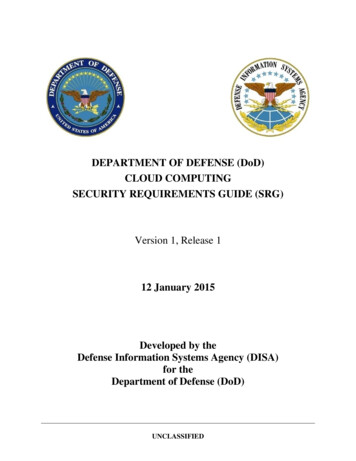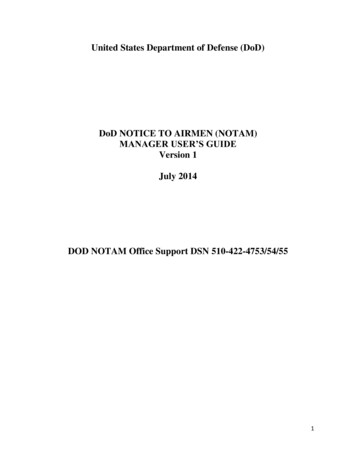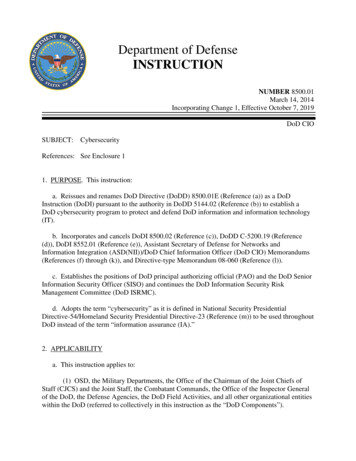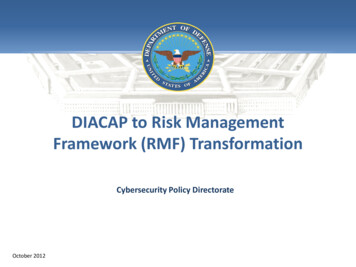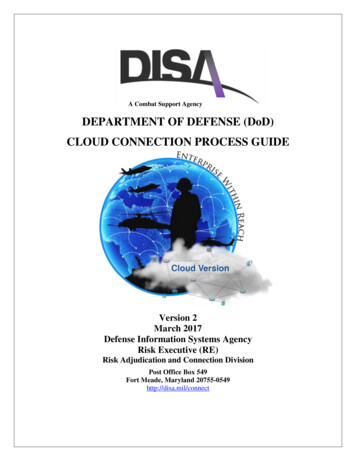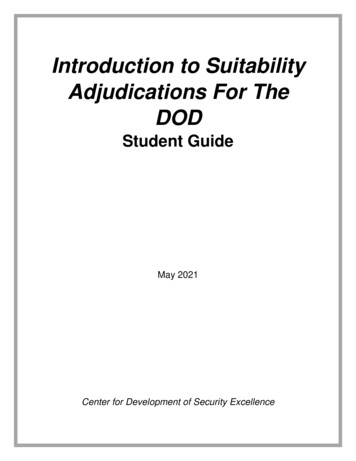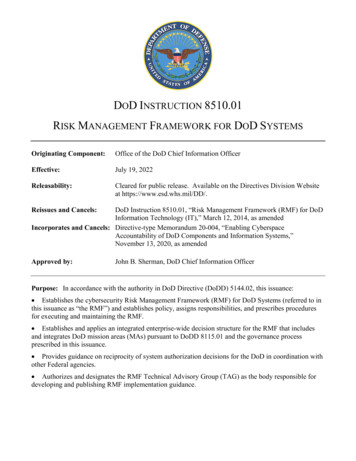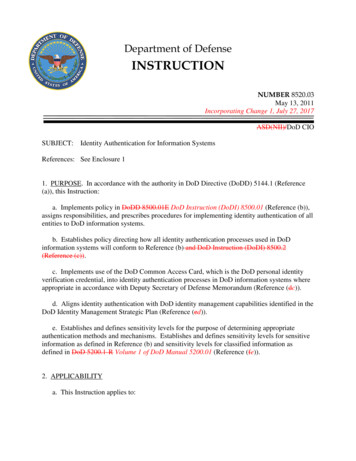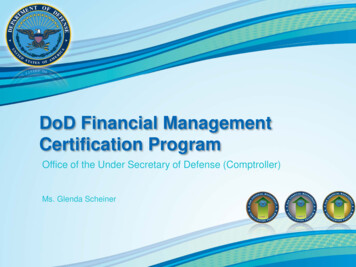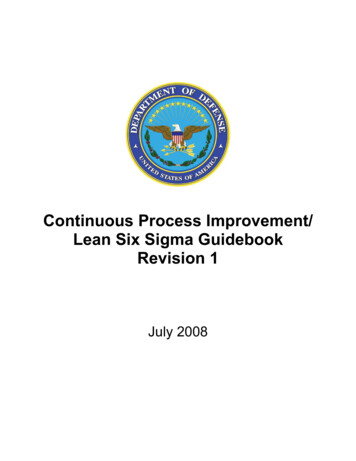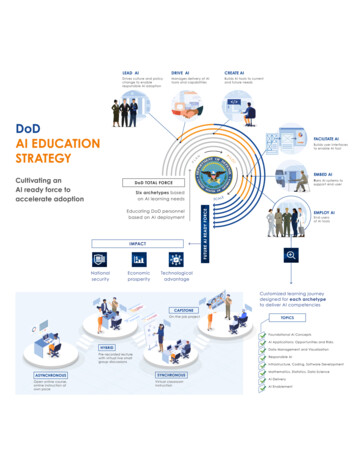
Transcription
DoD AI Education StrategyThe Department of Defense (DoD) is in the midst of a historic technological transformation. Withguidance from the DoD AI Strategy and the Digital Modernization Strategy, DoD will applytechnological innovations to transform all functions of the Department, thereby supporting and protectingU.S. servicemembers, safeguarding U.S. citizens, defending allies and partners, and improving theaffordability, effectiveness, and speed of our operations. As part of this broader technologicaltransformation, there is a strategic imperative for the Department to adopt Artificial Intelligence (AI) atspeed and at scale.The future of AI in the DoD relies on the Department’s ability to build and develop a workforce for thedigital era. AI is a human-centric endeavor – developed by people, for people – and because humans willultimately make the decisions that are informed by AI capabilities, an AI ready force is essential todelivering AI at scale. This includes both technical and non-technical roles, across all grades and ranks,civilian and military.However, there is a global war for talent. DoD is not yet postured to compete with industry in hiring thelarge numbers of experienced, top-tier AI talent needed to build and deploy AI across the DoD. As aresult, DoD must prioritize educating and training its incredibly diverse and talented workforce to deliverAI capabilities at scale across the Department.The large scale of the DoD workforce, though, requires targeting and sequencing education and traininginvestments with a focus on responsibly managing taxpayer dollars. As such, new investments will bedirected toward the groups that are critical to the priority objective of delivering AI capabilities at scale:DoD Senior Leaders and DoD Integrated Product Teams (IPTs). Senior leadership will catalyze broaderprocess and cultural change, enable modifications and reforms to policy, and send a top-down demandsignal to accelerate AI adoption. IPTs are multidisciplinary groups of Product Managers and AIdevelopers whose roles are central to delivering AI capabilities.DoD is beginning the implementation phase of the AI Education Strategy by kicking off a pilot in October2020 with an initial cadre of 84 Acquisitions and Requirements professionals from across the DoD. Thiscohort will go through an intensive program to be upskilled on AI technologies and how to definerequirements and procurement capabilities on behalf of DoD. The outcomes and feedback from the initialpilot will be used to quickly adapt and scale the program across the Department.DoD stands at a critical juncture in history, where adopting AI capabilities at speed and scale is essentialto maintain military advantage. DoD must develop world class AI practitioners to make AI real at theDepartment. Investments in AI education and training will serve the immediate DoD requirements whilesimultaneously increasing the U.S. national AI workforce capacity, bolstering U.S. security and economiccompetitiveness. Large-scale AI culture and competency development requires targeted upskillingacross the entire DoD workforce to unlock the potential of its most precious resource, its people.Establishing an overarching AI Education Strategy for the DoD workforce is a pivotal step in supportingthe Department’s transformation into the digital age and widescale adoption of AI.UNCLASSIFIED
DoD AI Education Strategyi2020 Department of Defense ArtificialIntelligence Education StrategyDelivered in Fulfillment of the Requirements outlined in Section 256 of the National DefenseAuthorization Act for Fiscal Year 2020 (Public Law 116-92).September 2020DoD Joint AI Center DoD Chief Information Officeri
DoD AI Education StrategyiiThis strategy is submitted in response to Section 256 of the National Defense Authorization Act (NDAA)for Fiscal Year (FY) 2020 (P.L. 116-92).Section 256 states:SEC. 256. ARTIFICIAL INTELLIGENCE EDUCATION STRATEGY. (a) STRATEGY REQUIRED.— (1)IN GENERAL.—The Secretary of Defense shall develop a strategy for educating service members inrelevant occupational fields on matters relating to artificial intelligence. (2) ELEMENTS.—The strategydeveloped under subsection (a) shall include a curriculum designed to give service members a basicknowledge of artificial intelligence. The curriculum shall include instruction in— (A) artificialintelligence design; (B) software coding; (C) potential military applications for artificial intelligence; (D)the impact of artificial intelligence on military strategy and doctrine; (E) artificial intelligence decisionmaking via machine learning and neural networks; (F) ethical issues relating to artificial intelligence;(G) the potential biases of artificial intelligence; (H) potential weakness in artificial intelligencetechnology; (I) opportunities and risks; and (J) any other matters the Secretary of Defense determines tobe relevant. (b) IMPLEMENTATION PLAN.—The Secretary of Defense shall develop a plan forimplementing the strategy developed under subsection (a). (c) SUBMITTAL TO CONGRESS.—Not laterthan 270 days after the date of the enactment of this Act, the Secretary of Defense shall submit to thecongressional defense committees— (1) the strategy developed under subsection (a); and (2) theimplementation plan developed under subsection (b).The below table provides the breakout of each section which the Strategy addresses as outlined in Section256 of the NDAA.Requirements(a) ArtificialIntelligenceEducation StrategyRequired InstructionPage number (Competency)(a) Curriculum8-9, 20, 25, 30, 35, 40, 45(A) Artificial intelligence design8 (AI enablement)(B) Software coding(C) Potential military applications(D) Impact of AI on military strategy anddoctrine(E) Artificial intelligence decision making viamachine learning and neural networks(F) Ethical issues relating to artificialintelligence(G) Potential biases of artificial intelligence(H) Weakness in artificial intelligencetechnology(I) Opportunities and risks8 (Software dev. & coding)8 (Foundational concepts)(J) Any other matters the Secretary of Defensedetermines to be relevant(b) ImplementationPlan1Plan to implement subsection (a)8 (AI delivery)8 (Foundational concepts)8 (Responsible AI1)8 (AI applications)8 (AI applications)8 (Foundational concepts)8 (Data management andvisualization, Mathematicsand statistics)11-14 (Lines of effort, keyperformance indicators,milestone schedule)Ethical considerations are a key part of the Responsible AI programDoD Joint AI Center DoD Chief Information Officerii
DoD AI Education StrategyiiiTable of Contents1Executive Summary . 12Strategic Context and Assumptions . 23Scope . 34Theory of Victory – Four Key Pillars for Success . 45Workforce AI Awareness, Education, and Training Program . 55.1Workforce Archetypes and Concentrations . 75.2Learning Outcomes . 75.3Competencies . 85.4Curriculum Building Blocks . 95.5Learning Journey . 106Governance . 127Implementation Plan . 137.1Lines of Effort . 137.2Key Performance Indicators. 157.3Milestone Schedule . 178Summary . 179Appendix A: Methodology and Organizations Consulted . 1810Appendix B: Lead AI Worker Archetype . 1911Appendix C: Drive AI Worker Archetype . 2412Appendix D: Create AI Worker Archetype . 2913Appendix E: Embed AI Worker Archetype . 3414Appendix F: Facilitate AI Worker Archetype . 3915Appendix G: Employ AI Worker Archetype . 4416Appendix H: Glossary. 49DoD Joint AI Center DoD Chief Information Officeriii
DoD AI Education Strategy1 Executive SummaryFiscal Year 2020 National Defense Authorization Act Section 256 requests the Secretary of Defensedevelop a strategy for educating service members in relevant occupational fields on artificial intelligence(AI). The strategy is to include a curriculum2 designed to give “service members in relevant occupationalfields” a basic knowledge of AI. The Department of Defense (DoD) elected to expand this mandate tocover the Total Force (to include the Active Component, Reserve Component, and civilian employees) inall career fields, as personnel in both technical and non-technical roles must work side-by-side to deliverand employ AI capabilities across the Department.DoD’s wide range of missions, complex personnel systems, lack of fully-deployed AI enterpriseinfrastructure and platform services, and relatively small but growing number of deployed AI use cases3drove a set of core assumptions used to formulate this strategy and implementation plan. Theseassumptions are: DoD is not postured yet to compete with industry (e.g., compensation, career paths, retention, oraccess to open-source tools) in hiring the large numbers of experienced, top-tier AI talent needed tobuild and deploy AI across the DoD; New investments in education and training should be directed toward enabling delivery of AIcapabilities at scale through the education and training of cohorts outside of the DoD’s current cadreof AI researchers; The large scale of the DoD workforce, as well as meeting the tenets of the Digital ModernizationStrategy, require integrating and targeting education and training investments with a focus onmanaging costs; and DoD investments in AI education and training must serve both immediate DoD requirements and,over the medium-term, increase the U.S. national AI workforce capacity to ensure any newinvestments pay long-term dividends to U.S. security and economic competitiveness.In responding to Section 256, DoD segmented its entire workforce into “archetypes;” those personnelwith similar AI education and training needs. DoD then used the archetypes as an analytical frameworkto inform key strategy decisions, including how DoD should prioritize and sequence new actions andinvestments, manage costs, and establish foundations needed to achieve a long-term vision for theDepartment’s digital workforce.In support of the DoD Chief Information Officer’s (CIO) Digital Modernization Strategy, DoD identifiedthe priority objective for the AI Education Strategy: to accelerate the delivery of AI capabilities at scale.This priority objective will focus the Department’s early actions and investments into four areas. First,DoD will prioritize AI awareness for senior leaders to build support, accelerate adoption, and catalyzebroader change. Second, DoD will upskill the segments of the workforce most directly involved in2Curriculum elements include: AI design, software coding, potential military applications of AI, AI decisionmaking via ML and Neural Networks, ethical issues relating to AI, the potential biases of AI, opportunities andrisks, any other matters the Secretary of Defense determines relevant.3Use cases correspond to a set of behaviors that the AI system may perform in interaction with its actors, and whichproduce an observable result that contribute to its goals (e.g., preventive maintenance optimization)1
DoD AI Education Strategydelivery of AI capabilities into multidisciplinary groups of personnel who comprise Integrated ProductTeams (IPTs).4 Third, DoD will prioritize establishing its broader vision for the digital workforce andseek to clarify how AI relates to other fields such as software engineering, cyber, and IT. This vision willhelp the Department reduce redundancies and inefficiencies across disciplines. Finally, DoD will certifyand track the deployment and integration of an AI ready force across the Components. DoD assessesthese four steps are critical to achieve the DoD AI Education Strategy’s priority objective in the quickestamount of time and for the least amount of cost.Supporting the AI Education Strategy’s priority objective requires sequencing training and education toaccelerate delivery of AI at scale while acknowledging resourcing and contextual limitations. In definingthis sequencing plan, DoD recognized that it must delay training and education for AI and datatechnicians (who are an integral part of the IPTs) to coincide with the deployment of AI enterpriseinfrastructure and platform services. Training a cadre of AI and data technicians before DoD has fieldedAI enterprise infrastructure and platform services that are necessary for these personnel to use their skillswould be early-to-need. As infrastructure and platform services become more widely available, DoDplans to scale education and training investments to all technical personnel on an IPT.DoD also recognized that it must pace the training of end-users with the deployment of AI capabilities.These users should receive application-specific training on relevant AI-related concepts at the same timeas capabilities are deployed so that they understand the strengths and limitations of AI capabilities.At full implementation, DoD’s AI Education Strategy will enable DoD’s Digital Modernization Strategy,the National Defense Strategy, the National Security Strategy, and DoD’s AI Strategy. It also has thepotential to grow the U.S. national AI workforce capacity as transitioning DoD personnel gain highlyrelevant skills needed to be successful in the digital economy. Coupled with the development of a talentcertification and tracking program, the JAIC plans to measure DoD’s progress as it integrates an AI-readyforce. The JAIC will seek to assist DoD Components in rationalizing and consolidating, where possible,existing AI educational offerings and services across DoD.2 Strategic Context and AssumptionsAs the United States looks to preserve and extend its competitive military advantage over potentialadversaries, the Department must continue to urgently implement its digital transformation strategy andadopt AI technologies at rapid speed and scale. Successful adoption of AI technologies into all aspects ofmilitary operations requires a fully-resourced, highly-educated and trained workforce, a coherent datastrategy and associated platform services, and the best available technology. Leveraging DoD’s longstanding culture of excellence in education and training and its diverse and talented workforce, DoD willfield an elite and world-class AI-ready force by implementing and scaling this AI Education Strategy.Four core assumptions underpin the Department’s strategy for AI education and training:DoD is not yet postured to compete with industry to hire the large numbers of experienced, top-tier AItalent needed to build and deploy AI across the DoD. AI and other digital technologies will be critical tofight and win the wars of the future. AI talent is in short supply and commercial companies have adistinct advantage over DoD with respect to recruitment, acquisition, and retention of top-flight AI4Integrated Product Teams addressed in Section 4, Subsection ii.2
DoD AI Education Strategytalent.5 DoD cannot afford to compete with private industry for enough AI technical talent to build anddeploy required capabilities at scale.New investments should be directed toward enabling delivery of AI capabilities at scale through theeducation and training of cohorts outside of the DoD’s current cadre of AI researchers. DoD’sresearch institutions boast a small cadre of deep technical expertise with a history of world-changinginnovations. These researchers are, by definition, experts in their field. However, due to the highdemand in commercial talent supply, and the associated costs of this workforce population, DoD cannotachieve its digital transformation goals simply by increasing its cadre of world-class researchers. DoDmust upskill cohorts beyond the confines of AI researchers to deliver AI at scale.The scale of the DoD workforce and its ambitious Digital Modernization Strategy require integratingand targeting education and training investments with a focus on managing costs. While a large-scaleupskilling program in industry means training 100,000 employees6, a similar program for the DoD meansdelivering education and training to a large workforce. DoD must accomplish this without overburdeningits financial and manpower resources, which means setting clear priorities and delaying investments ineducation and training for certain workforce segments until absolutely necessary. For example, if DoD’sAI Strategy is successful, the vast majority of DoD’s future workforce will use AI-enabled capabilities.Instead of training the entire workforce on AI applications in the near-term, DoD must deliver educationand training for its end-user population at pace with the actual deployment of AI capabilities.New DoD investments in AI education and training must serve both immediate DoD requirements and,over the medium-term, increase the U.S. national AI workforce capacity to ensure any new investmentspay long-term dividends to U.S. security and economic competitiveness. DoD will seek to create newcadres of AI workers, comprised of both military and federal civilian personnel, who can enhanceDepartment capabilities and, as they transition to positions outside of federal service, support privateindustry and help offset the scarcity of AI talent.These assumptions will guide and frame the Department’s approach to training and educating itspersonnel in AI fields over the next 5-7 years. Establishing this overarching AI Education Strategy for theDoD workforce is a pivotal step toward ensuring the U.S. military can fight and win future wars againstpeer competitors. This strategy rationalizes and consolidates, where possible, existing AI educationalofferings and services across DoD to leverage existing Component plans. The Department can achievethis critical endeavor in a way that minimizes the burden on taxpayers while simultaneously providingbroader benefits to our economic and technological might, all within the scope of defending our nation’speople and their security, prosperity, and freedom.3 ScopeThis strategy takes a Total Force approach, recognizing the need for cross-DoD coordination andacknowledging the importance of key dependencies such as enterprise infrastructure and platformservices.Total Force Approach. DoD’s AI Education Strategy expands the scope defined by the NDAA Section256 requirement. The expanded scope takes a Total Force approach by focusing on the ActiveComponent, Reserve Component, and civilian employees, as they work side-by-side identifying,5National Security Commission on Artificial Intelligence, Interim Report, Nov. 2019.Anand Chopra-McGowan, How Companies and Governments Can Advance Employee Education, HarvardBusiness Review, Sept. 2019.63
DoD AI Education Strategyintegrating, adapting, and employing AI. DoD’s AI Education Strategy also addresses all career fieldsbecause both technical and non-technical roles play an important part in the Digital ModernizationStrategy.7 However, select roles will require more specialized technical training and education.Cross-DoD coordination. DoD Components are developing AI education programs toaddress their unique requirements, but a common set of AI skills is needed across the Department.Currently, DoD lacks a consistent approach to coordinate, assess, or track AI skills. Simultaneously,related DoD-wide initiatives are underway to address other aspects of the larger digital workforce in areassuch as cyber and IT, software engineering, and product management.8,9,10,11 This strategy seeks tocoordinate with the broader digital workforce to pursue an enterprise approach12 to reduce duplicativepursuits and capture the efficiencies of delivering AI capabilities at scale.13Infrastructure and platform services. DoD’s AI workforce needs adequate technical infrastructure tosupport the procurement and delivery of AI capabilities at scale. This infrastructure must support realisticDoD-specific training opportunities for its personnel and lower the technical barriers to AI adoption.Over time, the JAIC’s infrastructure and platform services will provide key training capabilities insupport of the Secretary of Defense’s Joint Operational Training Infrastructure (JOTI) Strategy and willfacilitate on-the-job training. JAIC intends to field its platform services to all Service Academies andDoD universities so that DoD students are able to train in a real DoD environment.4 Theory of Victory – Four Key Pillars for SuccessA key strategy imperative is to articulate the theory of victory; that is, articulating the understanding ofhow decisions and actions taken increase the probability of achieving the desired objective. Therefore, insupport of the AI Education Strategy’s priority objective of accelerating the delivery of AI capabilities atscale, DoD believes near-term actions and investments in the four following areas are most likely to resultin achieving the desired objective in the quickest amount of time and for the least amount of cost.i.Prioritize AI awareness for senior leaders to build support, accelerate adoption, and catalyzebroader change. Senior leaders must understand what AI can do for defense, how to createorganizational AI and data management strategies and policies, how to employ AI-enabledmanpower, and how to make appropriate change management and resource allocation decisionsfor improved efficiencies made possible by AI adoption. By prioritizing the AI awareness ofleadership, DoD can build momentum such that its senior leaders can be drivers of effective andpositive culture change through scaling the identification, creation, and adoption of AI use cases.7The Joint Chiefs of Staff Vision and Guidance for Professional Military Education & Talent Management outlinesthe need to develop “practical warfighting skills” across the Joint Force of which AI will be an increasinglyimportant competency.8DoD Directive 8140.01, Cyberspace Workforce Management, Jul. 2017.9Sean Robson et al., Software Acquisition Workforce Initiative for the Department of Defense, RAND Corporation,2020.10DoD Digital Modernization Strategy, Jul. 2019.11Complimentary language can be found in the other FY20 NDAA workforce responses that highlight a preferencein a digital workforce that includes software, AI, and engineering.12Efforts are underway to deploy enterprise solutions for Human Resources Information Services to address longterm need for integration.13Summary of the 2018 Department of Defense Artificial Intelligence Strategy.4
DoD AI Education Strategyii. Create a cadre of Integrated Product Teams (IPTs)14 to deliver AI capabilities. The AIEducation Strategy prioritizes multidisciplinary groups of personnel who will have the greatestnear-term impact for accelerating the delivery of AI capabilities. The roles that make up IPTs arecentral to this goal; therefore, early education efforts will be focused here to ensure adequatetalent exists to deliver AI capabilities as the pace of adoption accelerates. While DoD must alsotrain its end-users to ensure they understand the limitations of AI systems and applicability ofmodels in real-world contexts, such training must take place when fielding new applications andcapabilities delivered by IPTs.iii. Create a common foundation for DoD’s digital workforce to enable integration, Joint effects,identification of overlaps and inefficiencies across disciplines, and gaps in training an AI-readyforce. Recognizing that the skillsets, experiences, and use case exposure across the DoDworkforce varies widely, DoD’s AI Education Strategy must describe its workforce and the roleof AI within the broader context of the definition of the Department’s digital workforce,including software engineering, cyber, and IT. This goes beyond individual competencies toinclude training the workforce on the technology foundations already in place within theDepartment, especially the DoD’s Joint Common Foundation (JCF). Foundational concepts thatare standardized across the Department, yet flexible for application within the Components, setthe necessary conditions for maximizing reuse and collaboration and delivering AI at scale.iv. Certify and track AI talent to enable deployment and integration of an AI ready force across theComponents. Scaling AI education and training needs to be complemented by an acceleration ofuse case adoption across the Department to provide crucial hands-on learning. Methods toidentify talent with AI skills and experience will be implemented and utilization will be tracked toensure the identified members of the AI workforce receive necessary on-the-job learningopportunities. By tracking AI talent, the Department can ensure the AI-ready force maintains itsproficiency and Components have the capability to deploy personnel with the necessary skillsetsacross the full range of operations.5 Workforce AI Awareness, Education, and Training ProgramAI awareness, education, and training are fundamental to AI-ready force planning and management (seeFigure 1). The AI Education Strategy seeks to advance AI understanding, knowledge, and skills of theTotal Force. However, it does not address all aspects of DoD’s human capital strategy for AI, nor does itnegate the need for broader workforce planning and establishing manpower requirements across the DoDComponents. The AI Education Strategy does, however, provide a common foundation of workforcearchetypes, i.e., groups with like AI education and training needs. Concentrations within archetypesallow for tailored learning based on AI-related roles. Together, these are useful analytical tools forestablishing similar educational requirements, understanding workforce sizing and shaping, and assistingin resource allocation decisions.14IPTs are composed of product managers, data scientists, AI/ML engineers, IT technicians, and UI/UX designersfrom the “Create AI”, “Drive AI”, and “Embed AI” archetypes.5
DoD AI Education StrategyFigure 1. Workforce planningDoD recognizes the importance of formal education, awareness, training, commercial partnerships, andon-the-job learning in relevant operational environments to keep pace with technological change anddrive delivery of AI capabilities for DoD personnel. The learning program defines the critical elementsfor a DoD AI-ready force, from worker archetypes through consolidated learning journeys. The programis intended as a common foundation, with the explicit intent that Components can tailor the program totheir unique mission and operational needs. The five key elements are: worker archetypes andconcentrations, learning outcomes, competencies curriculum building blocks; and learning journeyprogram design (see Figure 2). The following sections summarize the five key elements of the learningprogram. Additional archetype-specific details are included in the appendices.Figure 2. Learning Program Value Chain6
DoD AI Education Strategy5.1Workforce Archetypes and ConcentrationsThe AI workforce framework (see Figure 3) synthesizes input from Components, externalrecommendations, and commercial best practices.Figure 3. AI Workforce Archetypes and ConcentrationsNot all personnel who will execute DoD’s AI Strategy will have the same learning needs. Segmenting thepopulation of learners into archetypes aligns the full DoD population into differentiated cohorts based ontheir engagement with AI. For example, senior leaders who will build AI support, accelerate adoption,and catalyze broader change are encompassed in the “Lead AI” archetype.Each archetype has its own learning outcomes defined as an associated set of competency requirementsand curriculum, and a tailored learning journey. Archetypes allow for differentiation in the AI educationand training program across cohorts while keeping the offerings streamlined to implement at DoD-scale.Archetypes are not intended to replace military occupational sp
DoD's wide range of missions, complex personnel systems, lack of fully-deployed AI enterprise infrastructure and platform services, and relatively small but growing number of deployed AI use cases3 drove a set of core assumptions used to formulate this strategy and implementation plan. These assumptions are:
